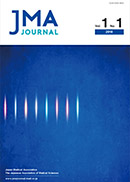Volume 5, Issue 3
Displaying 1-21 of 21 articles from this issue
- |<
- <
- 1
- >
- >|
Review Article
-
Article type: Review Article
2022Volume 5Issue 3 Pages 289-297
Published: July 15, 2022
Released on J-STAGE: August 03, 2022
Download PDF (2665K) -
Article type: Review Article
2022Volume 5Issue 3 Pages 298-306
Published: July 15, 2022
Released on J-STAGE: August 03, 2022
Download PDF (2767K) -
Article type: Review Article
2022Volume 5Issue 3 Pages 307-313
Published: July 15, 2022
Released on J-STAGE: August 03, 2022
Download PDF (6386K) -
Article type: Review Article
2022Volume 5Issue 3 Pages 314-318
Published: July 15, 2022
Released on J-STAGE: August 03, 2022
Download PDF (1820K)
Original Research Article
-
Article type: Original Research Article
2022Volume 5Issue 3 Pages 319-327
Published: July 15, 2022
Released on J-STAGE: August 03, 2022
Download PDF (2624K) -
Article type: Original Research Article
2022Volume 5Issue 3 Pages 328-333
Published: July 15, 2022
Released on J-STAGE: August 03, 2022
Download PDF (2524K) -
Article type: Original Research Article
2022Volume 5Issue 3 Pages 334-340
Published: July 15, 2022
Released on J-STAGE: August 03, 2022
Download PDF (1924K) -
Article type: Original Research Article
2022Volume 5Issue 3 Pages 341-348
Published: July 15, 2022
Released on J-STAGE: August 03, 2022
Download PDF (2521K) -
Article type: Original Research Article
2022Volume 5Issue 3 Pages 349-355
Published: July 15, 2022
Released on J-STAGE: August 03, 2022
Download PDF (3546K)
Opinion
-
Article type: Opinion
2022Volume 5Issue 3 Pages 356-361
Published: July 15, 2022
Released on J-STAGE: August 03, 2022
Download PDF (1828K)
Short Communication
-
Article type: Short Communication
2022Volume 5Issue 3 Pages 362-365
Published: July 15, 2022
Released on J-STAGE: August 03, 2022
Download PDF (2018K) -
Article type: Short Communication
2022Volume 5Issue 3 Pages 366-369
Published: July 15, 2022
Released on J-STAGE: August 03, 2022
Download PDF (2033K) -
Article type: Short Communication
2022Volume 5Issue 3 Pages 370-371
Published: July 15, 2022
Released on J-STAGE: August 03, 2022
Download PDF (1927K)
Images
-
Article type: Images
2022Volume 5Issue 3 Pages 372-374
Published: July 15, 2022
Released on J-STAGE: August 03, 2022
Download PDF (4525K) -
Article type: Images
2022Volume 5Issue 3 Pages 375-376
Published: July 15, 2022
Released on J-STAGE: August 03, 2022
Download PDF (2300K)
Editorial
-
Article type: Editorial
2022Volume 5Issue 3 Pages 377-378
Published: July 15, 2022
Released on J-STAGE: August 03, 2022
Download PDF (1792K)
Images
-
Article type: Images
2022Volume 5Issue 3 Pages 379-380
Published: July 15, 2022
Released on J-STAGE: August 03, 2022
Download PDF (5991K)
-
Article type: Case Report
2022Volume 5Issue 3 Pages 381-383
Published: July 15, 2022
Released on J-STAGE: August 03, 2022
Download PDF (3918K) -
Article type: Case Report
2022Volume 5Issue 3 Pages 384-388
Published: July 15, 2022
Released on J-STAGE: August 03, 2022
Download PDF (2332K) -
Article type: Case Report
2022Volume 5Issue 3 Pages 389-392
Published: July 15, 2022
Released on J-STAGE: August 03, 2022
Download PDF (7335K) -
Article type: Case Report
2022Volume 5Issue 3 Pages 393-397
Published: July 15, 2022
Released on J-STAGE: August 03, 2022
Download PDF (3373K)
- |<
- <
- 1
- >
- >|
